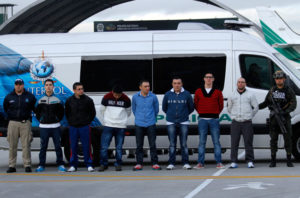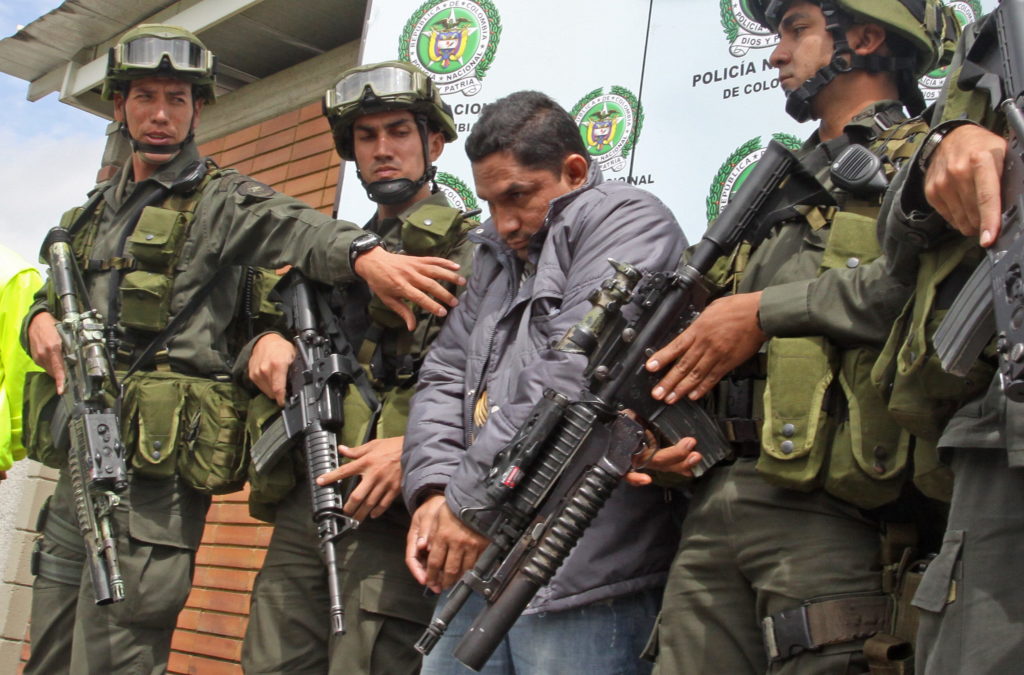A mix of ineptitude and indifference, along with a culture of victim-blaming, means justice is an illusion
Every time you see what we might call a “suspect” paraded in front of the media, you are seeing an example of what Colombian justice looks like. It’s a solitary person or group handcuffed together, a table full of drugs or guns (or both), knives and/or cellphones displayed before them. The damned – flanked by two neon-yellow police officers or olive-clad soldiers – do their best to cover their faces with hiked up t-shirt shirts or jackets. Sometimes they just hang their heads dutifully in shame.
I can think of other places in the world where this sort of thing is also common practice. The Philippines comes to mind. Though I can’t think of any of the so-called First World countries that do this so blatantly, at least not as a matter of policy. There is at least some presumption of innocence before a guilty verdict is rendered, something we might call due process. Not so in the Philippines, or in Colombia, or in most of the countries that make up Latin America for that matter.
Sure, the people marched out for the media are probably guilty, most of the time, while men in tailored suits in grandiose rooms who might represent them go through the motions of a trial, but their fate in an overcrowded jail cell has been sealed even before the first camera flash. The conclusion is so foregone that once the photo-op parade ends, the Colombian media don’t even bother following the vast majority of cases as they go to trial.
It’s another reminder that despite the towering stone monoliths that dwell in the centre of the Colombian capital, anything resembling justice, be it procedurally or otherwise, simply doesn’t exist. It might have existed once, or it may happen by fluke, like when Big Daddy USA gets involved, as was in the case when a DEA agent was stabbed to death in 2013 by a gang of taxi drivers in a botched robbery attempt. They were extradited to the US and will now spend most, if not all of their lives in a federal prison there. But when it is up to Colombians to dispense justice themselves, it’s mostly such a sad thing to watch that in order to avoid their general outlook grounding down to a pin of bitter nihilism, most, for the sake of their own sanity, simply look away.

DEA Agent James “Terry” Watson’s murderers lined up for the press just before their extradition, in April 2014. Before they were flown out of the country, many wept in front of television cameras and begged not to be sent to prison in the United States.
Talk to Colombians about this and they look at you like you’re touched in the head. They cock their head slightly to one side and stare at you blankly and wonder “why on Earth would you care about such things”? The average Colombian does not need to make an effort to actively ignore the shit-show that is their justice system. They possess an apathy that was introduced at a young age that hardened them from caring or worrying about what they see on the television news in the mornings, or during their lunch breaks. They are so accustomed to the apparatuses of the state and wider society simply not functioning because of corruption, stupidity, ineptitude and general throat-cutting and back-stabbing, that questioning why things are the way they are is inconceivable to them.
Foreigners who bother to pay attention to more than their weekend plans don’t have the same callus shielding them, so when they start to pay attention and care – or at least question why the flagrant injustice and violence that is on display day-in and day-out is permitted to exist – they are met with a blank stare and an unsympathetic ear. It touches a raw nerve, and forces you to look away from it all as well. Taking a breather from broken-society fatigue is necessary, and so too is the occasional self-proscribed ‘mental health’ day off.
Then happens something so outrageous that you simply cannot look away, you can’t let it go. It’s usually when so-called justice is applied too harshly, not enough, or at all – or when people escape justice because of money and social class.
‘Justice’ for the Rich
One striking example comes to mind. It isn’t even the most shocking, yet still worthy of note. In December 12, 2013, a woman by the name of Aura Andrea Molano got behind of the wheel of her car after having a few drinks, and drove onto the sidewalk and plowed into six people waiting for a bus in the north of Bogota – including an 11-year-old boy who was injured so severely that he had to have one of his legs amputated at the knee. At her trial, she pleaded not guilty, despite admitting later that she had been drinking and had indeed caused the accident. The case was eventually thrown out of court on a legal technicality, and the woman walked free.
The prosecutor in charge of the case apparently made a mistake in the legal procedure and did not file the charges with the right legal body in time, and because of this blunder, the judge could not render a verdict in the case. Her only punishment? An $884,300 peso ($450 USD) fine for seriously injuring the pedestrians, and crippling a child.
After she walked (something her 11-year-old victim will never do again), Molano had the gall to give an interview to the newspaper El Espectador. She claimed she had three-to-four beers, but denied that she was intoxicated while behind the wheel. She also said she had met with the families of the victims to discuss financial compensation. But the reason for the crash, according to Molano? “I lost consciousness for a second [while driving].”

Drink-driver Aura Andrea Molano gives her version of events during an interview with El Espectador newspaper in January, 2014. A month before, she maimed an 11-year-old while driving intoxicated, but was never charged for the crime.
Three weeks after the fact, presumably to cover their own asses, the Public Prosecutor’s Office released a statement appealing to the District 69 Municipal Criminal Judge of Bogota, who threw out the case on a technicality, to reconsider their decision and hold Molano pending a new trial. That was in February of 2014, and since the request, the court has not made a decision on the matter, or, because this is Colombia, they just forgot about it.
The almost comical irony in this case is that the crash came just two days after a new law was passed aimed at cracking down on drunk drivers, especially during the holiday season, when Colombians are known to partake more than average. The law was not applied in Molano’s case, everyone agrees, because she is a woman of means, who was flanked by two defence lawyers during her brief court appearance, before the Public Prosecutor fucked up the paperwork, which, as previously mentioned, allowed her to celebrate Christmas on two legs while a boy of lesser means could not, and can never do again.
This post would not be complete without mention of a travesty of justice so brazen and callous that even the most cynical Colombians put down their lunch forks and took notice. It was a crime and such a sinful unwillingness to correct it that it should turn the stomachs of anyone who believes that some kind of functioning society is important. On the night of Thursday, March 31st last year, a Bogota young man by the name of Wilson Sáenz, 25, was shot and killed in an apparent failed car-jacking attempt.
As he waited with his brother to pick up his wife and children from his uncle’s house in the Bogota district of Kennedy that night, two men with guns approached him and demanded that the two men get out of the vehicle. According to reports, this took place just as Sáenz’s wife was walking to the car with their small children, and the assailants fired two shots into the air to scare them off. There was some kind of altercation that resulted in the father-of-two being shot twice, once in the head. He died in hospital three days later. The two suspects were caught on CCTV cameras running from the scene and were soon apprehended by police – and despite various witnesses coming forward to positively identify the pair as the killers – were set free by the presiding district judge, ostensibly due to a lack of evidence.

Twenty-five-year-old Wilson Sáenz, seen in this undated photo. He was gunned down in Bogota in March, 2016. His killers were caught, but were later released by police.
The police were said to have questioned not the men with guns seen on camera running away from the scene of the murder, but the family of the victim, who were very curious as to why the car itself and the new 48” flat-screen TV in the boot were not stolen by the criminals, and for some reason, less curious about the driver who was fatally gunned down. In the quintessentially Colombian tradition of blaming the victim (No dar papaya!), officials responsible for policing the neighbourhood had launched a campaign urging motorists against parking their cars in the area at night.
There has been no further news reports of whether the police came to their senses and re-arrested the two killers. There was indignation on Twitter, Facebook, and in the comments section of the newspaper El Tiempo. But as is too often the case, day later, other shit happens, media attention shifts, and everyone but the victim’s family forgets (including the police). Sáenz’s widow, seven-year-old daughter and three-year-old son, presumably, carry on as best they can, always with the knowledge that their father’s/husband’s murderers not only still walk the same streets that they do, but were once caught by the police for the crime and then let go. And no one but they remember this; for the rest of Colombia, it is another story that hardens their hearts still further against the broken system they are forced to endure (and for the privileged few, ignore) because of the unfortunate lottery of where they were born.
These are only a two examples. There are too many others to detail here. The crimes that have been – and still are – committed in the chamber of horrors that is Latin America’s longest running civil conflict despite the peace treaty that was hammered out late last year. But that is mostly a story about Colombians who dwell in the countryside. In the country’s urban centres, the conflict is very different – dividing entire cites into three groups: the killers and thieves, the victims, and the cold and cynical bystanders.

Journalist. Misfit. Malcontent. Provocateur. Is a better Colombia is possible? We’re starting to have doubts.


Hello there! This post couldn’t be written much better!
Looking through this article reminds me of my previous roommate!
He constantly kept talking about this. I most certainly will send this post to him.
Pretty sure he’s going to have a very good read.
I appreciate you for sharing!